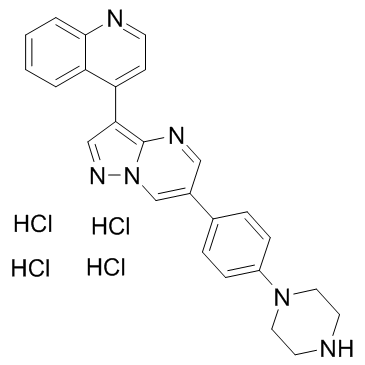| Description |
LDN193189 Hydrochloride is a BMP signaling inhibitor, inhibiting ALK1, ALK2, ALK3 and ALK6 with IC50s of 0.8, 0.8, 5.3, 16.7 nM, respectively.
|
| Related Catalog |
|
| Target |
IC50: 5 nM (ALK2), 30 nM (ALK3)[1]
|
| In Vitro |
LDN-193189 inhibits BMP4-mediated Smad1, Smad5 and Smad8 activation with greater potency than did dorsomorphin (IC50=5 nM versus 470 nM) while retaining 200-fold selectivity for BMP signaling versus TGF-β signaling (IC50 for TGF-β ≥1,000 nM). LDN-193189 efficiently inhibits transcriptional activity of the BMP type I receptors ALK2 and ALK3 (IC50=5 nM and 30 nM, respectively), with substantially weaker effects on activin and the TGF-β type I receptors ALK4, ALK5 and ALK7 (IC50≥500 nM) and increases selectivity for BMP signaling versus AMP-activated protein kinase, PDGFR and MAPK signaling pathways as compared to the parent compound. LDN-193189 blocks the transcriptional activity induced by either constitutively active ALK2R206H or ALK2Q207D mutant proteins. These findings suggest that LDN-193189 might affect BMP-induced osteoblast differentiation. In fact, LDN-193189 inhibits the induction of alkaline phosphatase activity in C2C12 cells by BMP4 even when administered 12 h after BMP stimulation, indicating sustained BMP signaling activity is needed for osteogenic differentiation[1].
|
| In Vivo |
In the first experiment, LDN-193189 (3 mg/kg) is injected intraperitoneally twice a day after tumors became palpable 7 days post-implantation. The growth rates between the control vehicle- and LDN-193189-treated mice are not significantly different after the first 5 weeks, but differences in the growth rates are detected after 6 and 7 weeks post-treatment. In the second experiment, cells are isolated from PCa-118b tumors and injected subcutaneously into SCID mice (1×106 cells per mouse). LDN-193189 or vehicle is applied to mice 5 days post-tumor cell injection before tumors are palpable. The differences in the average growth rates between these two groups, as measured by tumor size, are significant at 6 and 7 weeks post-treatment. The tumor weights also show significant differences at the termination of the study at week 7. The X-ray of the tumors shows that the ectopic bone volume and bone density are reduced in the tumors of LDN-193189-treated group compared to that of controls[2]. Co-incubation of pulmonary arterial smooth muscle cells (PASMCs) from the pulmonary arterial hypertension (PAH) rats with Sildenafil and LDN-193189 completely inhibited the anti-proliferation and up-regulation of the bone morphogenetic protein (BMPR2) and Cx40 expression by the Sildenafil[3].
|
| Kinase Assay |
C2C12 cells are seeded into 96-well plates at 2,000 cells per well in DMEM supplemented with 2% FBS. The wells are treated in quadruplicate with BMP ligands and LDN-193189 or vehicle. The cells are collected after 6 d in culture in 50 μL Tris-buffered saline and 1% Triton X-100. The lysates are added to p-nitro-phenylphosphate reagent in 96-well plates for 1 h and then evaluated alkaline phosphatase activity (absorbance at 405 nm). Cell viability are measured and quantity by Cell Titer Aqueous One (absorbance at 490 nm), using replicate wells treated identically to those used for alkaline phosphatase measurements[1].
|
| Cell Assay |
Mouse PASMCs grown are transiently transfected to 50% confluence in six-well plates with 0.3 μg Id1promoter luciferase reporter construct (BRE-Luc) in combination with 0.6 μg of plasmid expressing constitutively active forms of BMP type I receptors (caALK2, caALK3 or caALK6), using Fugene6. To assess activin and TGF-β type I receptor function, PASMCs are transiently transfected with 0.3 μg PAI1 (plasminogen activator inhibitor-1) promoter luciferase reporter construct (CAGA-Luc) in combination with 0.6 μg of plasmid expressing constitutively active forms of type I receptors (caALK4, caALK5 and caALK7). For both reporter plasmids, 0.2 μg of pRL-TKRenilla luciferase are used to control for transfection efficiency. PASMCs are incubated with LDN-193189 (2 nM-32 μM) or vehicle starting 1 h after transfection. Cell extracts are harvested and quantified relative promoter activity by the ratio of firefly to Renilla luciferase activity with the dual luciferase assay kit[1].
|
| Animal Admin |
Mice[2] In the first experiment, SCID mice are implanted with MDA-PCa-118b tumors. After 7 days when tumors reached measurable sizes, mice are injected with LDN-193189 (3 mg/kg) or with vehicle intraperitoneally twice a day. Tumor sizes and body weights are measured weekly. Mice are injected with calcein at three days and one day prior to sacrifice. Blood is collected and tumors are weighed. A portion of the tumors are fixed in formaldehyde for micro-computed tomography (microCT), using EVS CT, or further decalcified for bone histomorphometric analysis, using OsteoMeasure Analysis System, or flash frozen for RNA preparation. Osteocalcin in the mouse serum is determined by ELISA. In the second experiment, PCa-118b tumors are first digested with Accumax, and the isolated cells are plated overnight, resuspended in Matrigel in 1:1 ratio, and injected into SCID mice (1×106 cells/mouse) subcutaneously. Mice are treated with LDN-193189 five days post-injection. Rats[3] Male Sprague-Dawley (SD) rats, 8 weeks of age, weighing 200-220 g, are purchased from Nanjing Medical University animal center. Rats are randomly assigned to one of seven experiment groups (n=6 per group). Rats are housed with free access to food and water under a natural 12/12 h day/night cycle. The Monocrotaline is administered (60 mg/kg) to rats by subcutaneous injection into the back region. The animal’s lungs are harvested at 28th day of the study after hemodynamic assessment. The Sildenafil group received daily intragastric administration of Sildenafil after the administration of MCT (60 mg/kg). The LDN-193189 group received daily intragastric administration of Sildenafil (50 mg/kg) and intraperitoneal injection of LDN-193189 (10 mg/kg). In other groups, the same volume saline is given.
|
| References |
[1]. Yu PB, et al. BMP type I receptor inhibition reduces heterotopic [corrected] ossification. Nat Med, 2008, 14(12), 1363-1369. [2]. Lee YC, et al. BMP4 promotes prostate tumor growth in bone through osteogenesis. Cancer Res, 2011, 71(15), 5194-5203. [3]. Yang L, et al. Sildenefil increases connexin 40 in smooth muscle cells through activation of BMP pathways in pulmonary arterial hypertension. Int J Clin Exp Pathol. 2014 Jul 15;7(8):4674-84.
|
